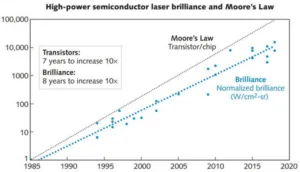The short answer is: a lot brighter than they are today. And probably sooner than you might think.

Everyone knows that in 1960 Theodore Maiman of Hughes Aircraft Company built the first laser: an optically pumped system using synthetic ruby as the lasing medium. (You did know that, didn’t you?) Less commonly known is that the first laser diode was demonstrated in 1962. In September of that year, Robert Hall’s team at the General Electric Research Labs demonstrated infrared emission from a gallium arsenide (GaAs) semiconductor.
Hall had been looking at GaAs as a LED material but decided to polish the two ends. Apparently he was surprised when the light emitted showed interference patterns, i.e. the light was coherent, i.e. he had built a semiconductor laser. Similar work was done that same year at IBM and the Lincoln Laboratory at MIT. These groups also used GaAs, still a common material for infra-red diode lasers. Hall had been inspired, at least in part, by reports form the Lincoln Laboratory about much higher GaAs efficiency than he had been able to obtain.
![]() Patent on the first laser diode, applied for about a month after Robert Hall’s first demonstration. The GE patent lawyers knew a good thing when they saw it.
Patent on the first laser diode, applied for about a month after Robert Hall’s first demonstration. The GE patent lawyers knew a good thing when they saw it.
The rest is history. Currently, commercial diode lasers are made with a wide variety of materials and are available in wavelengths from 375 nm to 3500 nm. Display engineers are mostly interested in the range from 440 nm to 640 nm although wavelengths as short as 405 nm can be used in laser-phosphor systems. Blue and green semiconductor lasers are generally made from GaN and red lasers from GaP. GaAs 1064 nm laser diodes can be frequency-doubled to produce 532 nm green light, although the improvements in GaN green lasers is making this less common than even a couple years ago.
To get back to the question “How Bright Can Lasers Get?” Manoj Kanskar, Scott Keeney and Robert Martinsen from nLight published an article in January’s Laser Focus World titled “The power of brilliance—the past and future of high-power semiconductor lasers.”
They define “Brilliance” as Watts/Cm²-sr. Since nLight makes infrared lasers, not visible lasers, their use of watts is perfectly understandable, although if someone were to do a similar study for visible lasers, they would probably look at Lumens/Cm²-sr. This brilliance is a measure of the power or lumen density of the laser output. It is, in fact, important to display designers interested in using semiconductor lasers as a light source, either for projection displays or edge-lit LCDs. The higher the brilliance of a laser, the higher the amount of light you can fit into a small space such as a scanning mirror, a small DLP imager or a thin LCD light guide.
High-power semiconductor laser brilliance and Moore’s Law are compared. (Credit M. Kanskar et. al. in Laser Focus World, January 2018)
Kanskar and his colleagues compared the increase in brilliance in laser diodes to Moore’s law for transistors and found a similar exponential growth over time, as shown in the figure. According to Moore’s Law, the number of transistors have increased by a factor of 10 every seven years. For semiconductor lasers, the increase in brilliance has been a factor of 10 every eight years. Still pretty fast.
According to their data, there is no sign of the increase tapering off in the next few years and there is no obvious theoretical reason why it should. Transistor density will be limited when transistors reach the size of small groups of atoms and Moore’s law will taper off with no shrinking of the transistors possible after that. Maybe there is an equivalent limit with lasers, but the authors did not suggest one and I don’t know of one.
![]() The continuously reducing cost of high-power semiconductor laser brilliance fuels applications. (Normalized cost per bright watt*) [*Bright Watt = Brilliance (W/cm2 -sr)]. (Credit M. Kanskar et. al. in Laser Focus World, January 2018)
The continuously reducing cost of high-power semiconductor laser brilliance fuels applications. (Normalized cost per bright watt*) [*Bright Watt = Brilliance (W/cm2 -sr)]. (Credit M. Kanskar et. al. in Laser Focus World, January 2018)
Along with the increase in brilliance, the authors documented the decrease in cost. Like the increase in brilliance, the price per unit brilliance has been declining exponentially over their study period from 1985 to the present. While this only applies directly to infrared semiconductor lasers, again I suspect a similar diagram could be drawn for visible lasers, especially for GaN blue and green lasers since Dr. Shuji Nakamura developed the first practical GaN LEDs in 1993.
So what is the brightest laser diode commercially available today? At Photonics West 2017, nLight announced what at the time was said to be the highest brilliance IR laser diode laboratory system with 220W from a 105µm fiber, a version of which is now commercially available from nLight with 220W from a 200µm diameter fiber.
So what is the brightest laser diode system anywhere, commercial or not? Probably the Diocles Laser at the Extreme Light Laboratory at the University of Nebraska–Lincoln with a power output of 100 TW, although it only maintains that output for 10-14 seconds with a pulse repetition frequency of 10Hz. The brightness of this laser is said to be about one billion times the brightness of the sun. It is currently being used to investigate high-order, non-linear Thomson scattering, a process not previously observed on Earth but believed to take place in super-nova explosions. According to Dr. Donald Umstadter, head of the Extreme Light Laboratory, the laser does have Earthly uses and is small and inexpensive enough for hospitals to potentially use it for cutting-edge cancer therapy. Is this the brightest possible laser? I wouldn’t bet on it. –Matthew Brennesholtz

